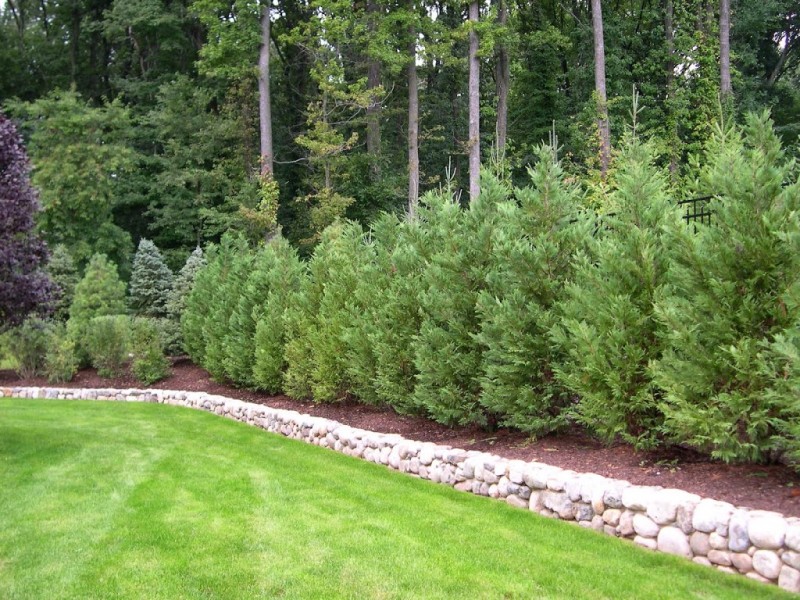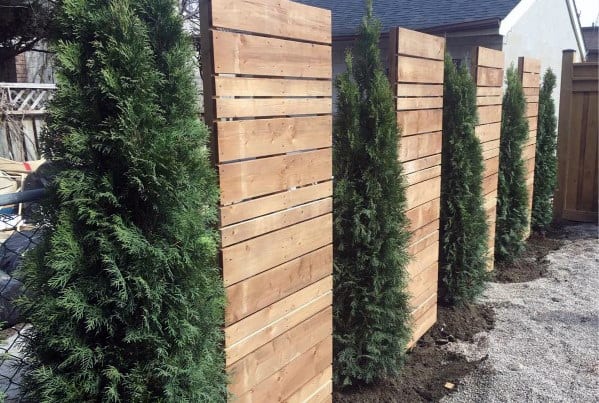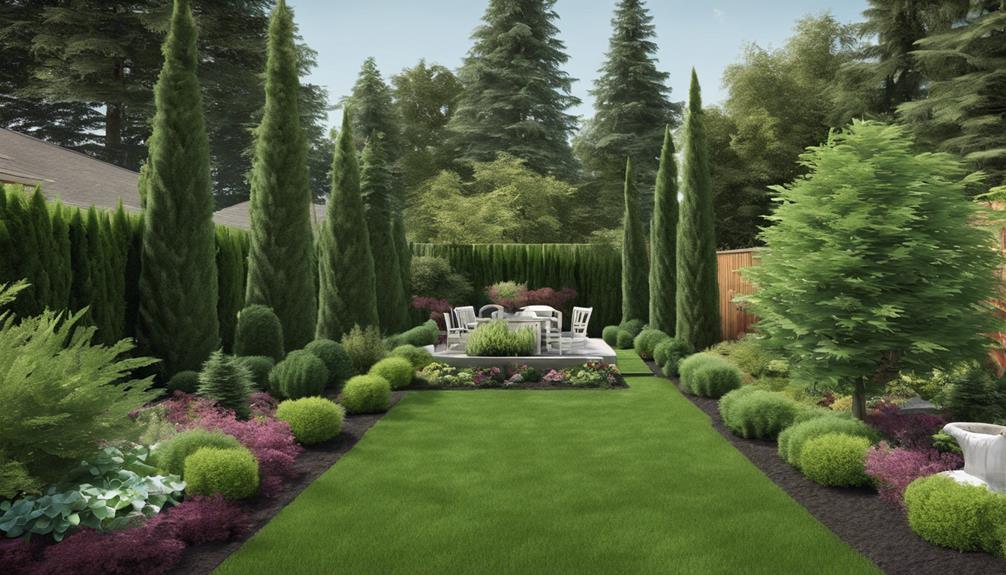Why Trees Make the Best Privacy Fences
When it comes to creating a private oasis, a natural barrier is often the most effective and aesthetically pleasing solution. Trees have long been used as a means of blocking out unwanted views and noise, and for good reason. Not only do they provide a beautiful and lush screen, but they also offer a range of environmental benefits that traditional fencing materials simply can’t match.
One of the primary advantages of using trees as a privacy fence is their ability to reduce noise pollution. Unlike traditional fences, which can often amplify noise, trees have a unique ability to absorb and deflect sound waves. This makes them an ideal choice for homes located near busy roads or noisy neighbors.
In addition to their noise-reducing properties, trees also offer a range of environmental benefits. They provide oxygen, absorb carbon dioxide, and support local wildlife, making them a valuable addition to any landscape. And, with the right species selection, trees can be used to create a beautiful and effective privacy fence that requires minimal maintenance.
So, what makes a tree the best tree for a privacy fence? The answer lies in its ability to provide a natural screen that is both beautiful and functional. With the right combination of growth rate, mature size, and maintenance requirements, trees can be used to create a private oasis that is both peaceful and picturesque.
Whether you’re looking to block out unwanted views, reduce noise pollution, or simply create a beautiful and natural screen, trees are an ideal choice for a privacy fence. With their range of environmental benefits and aesthetic appeal, it’s no wonder that trees are becoming an increasingly popular choice for homeowners looking to create a private oasis.
How to Choose the Right Tree for Your Privacy Needs
When it comes to selecting the best tree for a privacy fence, there are several factors to consider. The right tree can provide a natural screen that is both beautiful and effective, while the wrong tree can be a maintenance nightmare. To ensure that you choose the best tree for your privacy needs, consider the following factors:
Growth rate is an important consideration when selecting a tree for a privacy fence. Fast-growing trees can quickly provide privacy, but they may require more maintenance than slower-growing trees. Some popular fast-growing tree species for privacy fencing include Arborvitae and Leyland Cypress. These trees can grow up to 3-5 feet per year, making them an ideal choice for homeowners who want to quickly establish a natural screen.
Mature size is another important factor to consider when selecting a tree for a privacy fence. Trees that are too small may not provide adequate privacy, while trees that are too large may overwhelm the surrounding landscape. Consider the mature size of the tree and how it will fit into your landscape. Some popular tree species for privacy fencing, such as Spruce and Fir, can grow up to 50-60 feet tall, making them an ideal choice for larger landscapes.
Maintenance requirements are also an important consideration when selecting a tree for a privacy fence. Some trees require regular pruning and maintenance to keep them healthy and looking their best. Consider the maintenance requirements of the tree and whether they fit into your lifestyle. Some popular low-maintenance tree species for privacy fencing include Boxwood and Holly.
Finally, consider the climate and soil conditions in your area when selecting a tree for a privacy fence. Some trees are better suited to certain climates and soil conditions than others. Consider the hardiness zone and soil requirements of the tree and whether they fit into your landscape. Some popular tree species for privacy fencing, such as Oak and Maple, are well-suited to a variety of climates and soil conditions.
By considering these factors, you can choose the best tree for your privacy needs and create a natural screen that is both beautiful and effective. Whether you’re looking for a fast-growing tree, a low-maintenance tree, or a tree that is well-suited to your climate and soil conditions, there are many options to choose from. With the right tree, you can create a private oasis that is both peaceful and picturesque.
Fast-Growing Trees for Quick Privacy
When it comes to creating a private oasis, time is often of the essence. Homeowners who want to quickly establish a natural screen may want to consider fast-growing tree species. These trees can provide rapid growth and quick results, making them an ideal choice for those who want to create a private space in a short amount of time.
Eucalyptus is a popular fast-growing tree species that can quickly provide privacy. This tree can grow up to 4 feet per year, making it an ideal choice for homeowners who want to quickly establish a natural screen. Eucalyptus is also a low-maintenance tree that requires minimal pruning and care, making it a great choice for busy homeowners.
Bamboo is another fast-growing tree species that can quickly provide privacy. This tree can grow up to 3 feet per year, making it an ideal choice for homeowners who want to quickly establish a natural screen. Bamboo is also a highly durable tree that can withstand harsh weather conditions, making it a great choice for homeowners who live in areas with extreme weather.
While fast-growing trees can provide quick results, they also have some drawbacks. These trees may require more maintenance than slower-growing trees, as they can quickly become overgrown and unruly. Additionally, fast-growing trees may not be as durable as slower-growing trees, as they may be more prone to disease and pests.
Despite these drawbacks, fast-growing trees can be a great choice for homeowners who want to quickly establish a natural screen. By choosing the right fast-growing tree species and providing proper care and maintenance, homeowners can create a private oasis that is both beautiful and functional.
Some other fast-growing tree species that can quickly provide privacy include:
- Willow: This tree can grow up to 6 feet per year and is a great choice for homeowners who want to quickly establish a natural screen.
- Poplar: This tree can grow up to 4 feet per year and is a great choice for homeowners who want to quickly establish a natural screen.
- Paulownia: This tree can grow up to 3 feet per year and is a great choice for homeowners who want to quickly establish a natural screen.
By considering these fast-growing tree species, homeowners can create a private oasis that is both beautiful and functional. Whether you’re looking for a quick solution or a long-term investment, fast-growing trees can provide the perfect solution for your privacy needs.
Evergreen Trees for Year-Round Privacy
When it comes to creating a private oasis, evergreen trees are an excellent choice. These trees provide year-round privacy, as they maintain their foliage throughout the seasons. Unlike deciduous trees, which shed their leaves in the fall, evergreen trees remain green and lush, providing a natural screen that is both beautiful and effective.
Spruce and Fir are two popular evergreen tree species that are well-suited for privacy fencing. These trees are known for their dense, compact growth habit, which makes them ideal for creating a natural screen. They are also relatively low-maintenance, as they require minimal pruning and care.
One of the benefits of using evergreen trees for privacy fencing is their ability to provide year-round coverage. Unlike deciduous trees, which may lose their leaves in the fall, evergreen trees remain green and lush, providing a natural screen that is both beautiful and effective. This makes them an ideal choice for homeowners who want to create a private oasis that is both peaceful and picturesque.
Another benefit of using evergreen trees for privacy fencing is their ability to provide a natural sound barrier. The dense foliage of evergreen trees can help to block out noise pollution, creating a peaceful and serene environment that is perfect for relaxation and recreation.
In addition to their practical benefits, evergreen trees are also a popular choice for privacy fencing due to their aesthetic appeal. They come in a variety of shapes and sizes, and can be used to create a natural screen that is both beautiful and effective. Whether you’re looking for a formal, manicured look or a more natural, rustic appearance, evergreen trees are an excellent choice.
Some other evergreen tree species that are well-suited for privacy fencing include:
- Arborvitae: This tree is known for its dense, compact growth habit, making it ideal for creating a natural screen.
- Cedar: This tree is known for its distinctive, aromatic foliage, which makes it a popular choice for privacy fencing.
- Cypress: This tree is known for its tall, slender growth habit, making it ideal for creating a natural screen that is both beautiful and effective.
By choosing the right evergreen tree species and providing proper care and maintenance, homeowners can create a private oasis that is both peaceful and picturesque. Whether you’re looking for a natural sound barrier, a beautiful screen, or a low-maintenance solution, evergreen trees are an excellent choice for privacy fencing.
Ornamental Trees for a Decorative Privacy Fence
When it comes to creating a private oasis, ornamental trees can add a touch of beauty and elegance to a privacy fence. These trees are not only functional, but also provide a decorative element that can enhance the overall aesthetic of a landscape. In this section, we will explore some popular ornamental tree species that can add beauty and interest to a privacy fence.
Flowering Cherry is a popular ornamental tree species that can add a touch of beauty to a privacy fence. This tree is known for its stunning pink or white flowers that bloom in the spring, creating a beautiful display of color and fragrance. Flowering Cherry is also a relatively low-maintenance tree that requires minimal pruning and care.
Redbud is another popular ornamental tree species that can add beauty and interest to a privacy fence. This tree is known for its stunning pink or purple flowers that bloom in the spring, creating a beautiful display of color and fragrance. Redbud is also a relatively low-maintenance tree that requires minimal pruning and care.
Ornamental trees can provide a range of benefits for a privacy fence, including:
- A decorative element: Ornamental trees can add a touch of beauty and elegance to a privacy fence, creating a unique and interesting landscape feature.
- Wildlife habitat: Ornamental trees can provide a habitat for wildlife, such as birds and butterflies, adding to the overall biodiversity of a landscape.
- Noise reduction: Ornamental trees can help to reduce noise pollution, creating a more peaceful and serene environment.
Some other ornamental tree species that can add beauty and interest to a privacy fence include:
- Crabapple: This tree is known for its stunning pink or white flowers that bloom in the spring, creating a beautiful display of color and fragrance.
- Dogwood: This tree is known for its stunning white or pink flowers that bloom in the spring, creating a beautiful display of color and fragrance.
- Japanese Maple: This tree is known for its stunning red or purple foliage, creating a beautiful display of color and texture.
By incorporating ornamental trees into a privacy fence, homeowners can create a unique and interesting landscape feature that adds beauty and elegance to their outdoor space. Whether you’re looking for a decorative element, a wildlife habitat, or a noise reduction solution, ornamental trees are an excellent choice for a privacy fence.
Tree Planting and Maintenance Tips
Planting and maintaining trees for a privacy fence requires careful consideration and attention to detail. By following these tips, you can ensure that your trees thrive and provide the desired level of privacy and beauty to your outdoor space.
Soil Preparation: Before planting your trees, it’s essential to prepare the soil properly. This includes testing the pH level of the soil and adding any necessary amendments to ensure optimal growth. Additionally, make sure to remove any debris or weeds that may compete with your trees for water and nutrients.
Watering: Trees need adequate water to grow and thrive, especially during the first year after planting. Make sure to water your trees regularly, but avoid overwatering, which can lead to root rot and other problems.
Pruning: Pruning is an essential part of tree maintenance, as it helps to promote healthy growth and maintain the desired shape and size of your trees. Prune your trees annually, removing any dead or diseased branches and shaping the tree to maintain its natural form.
Mulching: Mulching around the base of your trees can help to retain moisture, suppress weeds, and regulate soil temperature. Use a layer of organic mulch, such as wood chips or bark, to create a 2-3 inch layer around the base of your trees.
Pest and Disease Management: Regularly inspect your trees for signs of pests or disease, and take action promptly if you notice any problems. Use organic or integrated pest management methods whenever possible to minimize the impact on the environment.
Some other tips to keep in mind when planting and maintaining trees for a privacy fence include:
- Choose the right tree species for your climate and soil type.
- Plant trees at the right time of year, typically in the fall or early spring.
- Space trees correctly, taking into account their mature size and growth habits.
- Monitor tree health regularly, and take action promptly if you notice any problems.
By following these tips, you can ensure that your trees thrive and provide the desired level of privacy and beauty to your outdoor space. Remember to always choose the best tree for your privacy fence needs, and provide proper care and maintenance to ensure a long and healthy life for your trees.
Real-Life Examples of Beautiful Tree Privacy Fences
When it comes to creating a private oasis, trees can be a beautiful and effective solution. Here are some real-life examples of beautiful tree privacy fences that showcase the benefits of using trees as a natural privacy fence.
Example 1: Arborvitae Hedge
A homeowner in California wanted to create a private oasis in their backyard. They planted a row of Arborvitae trees along their fence line, which provided a natural screen and blocked out the view of their neighbors. The trees were spaced 3-4 feet apart and were pruned regularly to maintain a uniform shape.
Example 2: Leyland Cypress Screen
A homeowner in Florida wanted to create a private area in their front yard. They planted a row of Leyland Cypress trees along their fence line, which provided a natural screen and blocked out the view of the street. The trees were spaced 5-6 feet apart and were pruned regularly to maintain a uniform shape.
Example 3: Flowering Cherry Tree Border
A homeowner in Oregon wanted to create a beautiful and private border in their backyard. They planted a row of Flowering Cherry trees along their fence line, which provided a natural screen and added a pop of color to their landscape. The trees were spaced 3-4 feet apart and were pruned regularly to maintain a uniform shape.
These examples showcase the benefits of using trees as a natural privacy fence. By choosing the right tree species and providing proper care and maintenance, homeowners can create a beautiful and effective privacy fence that adds value to their property.
Some other benefits of using trees as a natural privacy fence include:
- Aesthetic appeal: Trees can add beauty and interest to a landscape, making them a popular choice for homeowners who want to create a private oasis.
- Environmental benefits: Trees can provide shade, reduce noise pollution, and create a natural habitat for wildlife.
- Low maintenance: Trees require minimal maintenance, making them a low-maintenance solution for homeowners who want to create a private oasis.
By incorporating trees into their landscaping project, homeowners can create a beautiful and effective privacy fence that adds value to their property. Whether you’re looking for a natural screen, a decorative element, or a low-maintenance solution, trees are an excellent choice for a privacy fence.
Conclusion: Creating a Private Oasis with Trees
Creating a private oasis with trees is a great way to add beauty, functionality, and value to your property. By choosing the right tree species and providing proper care and maintenance, you can create a natural privacy fence that is both effective and attractive.
Throughout this article, we have discussed the benefits of using trees as a natural privacy fence, including their aesthetic appeal, noise reduction, and environmental benefits. We have also provided tips and considerations for selecting the best tree species for your privacy needs, including factors such as growth rate, mature size, and maintenance requirements.
In addition, we have highlighted fast-growing tree species that can quickly provide privacy, such as Eucalyptus and Bamboo. We have also focused on evergreen tree species that provide year-round privacy, such as Spruce and Fir, and ornamental tree species that can add beauty and interest to a privacy fence, such as Flowering Cherry and Redbud.
By incorporating trees into your landscaping project, you can create a beautiful and effective privacy fence that adds value to your property. Whether you’re looking for a natural screen, a decorative element, or a low-maintenance solution, trees are an excellent choice for a privacy fence.
In conclusion, creating a private oasis with trees is a great way to add beauty, functionality, and value to your property. By choosing the right tree species and providing proper care and maintenance, you can create a natural privacy fence that is both effective and attractive. Consider using trees in your next landscaping project and enjoy the many benefits they have to offer.








